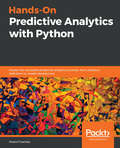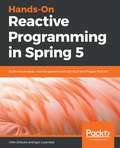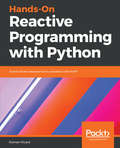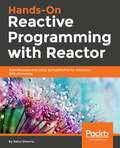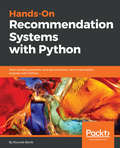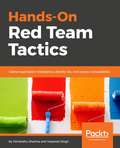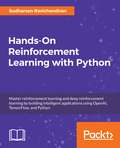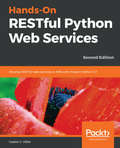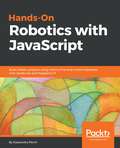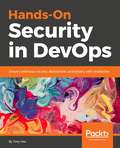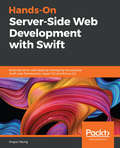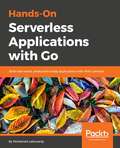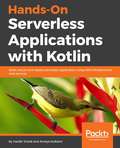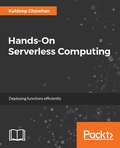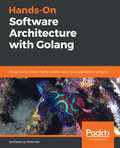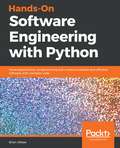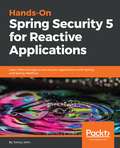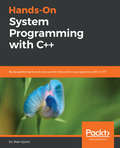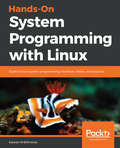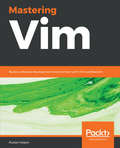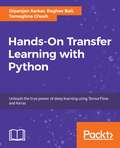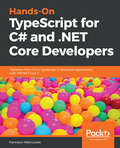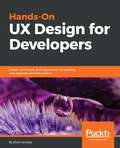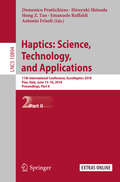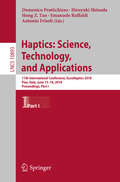- Table View
- List View
Hands-On Predictive Analytics with Python: Master the complete predictive analytics process, from problem definition to model deployment
by Alvaro FuentesThis book is for Python programmers who wants to learn predictive modeling and aspire to enter data science and machine learning areas. All you need is basic familiarity with linear algebra and statistical knowledge.
Hands-On Reactive Programming in Spring 5: Build cloud-ready, reactive systems with Spring 5 and Project Reactor
by Oleh Dokuka Igor LozynskyiExplore the reactive system and create efficient microservices with Spring Boot 2.1 and Spring CloudKey FeaturesUnderstand the kind of system modern businesses require with SpringGain deeper insights into reactive programming with Reactor and Spring CloudGet in-depth knowledge on asynchronous and nonblocking communication with Spring 5 WebFluxBook DescriptionThese days, businesses need a new type of system that can remain responsive at all times. This is achievable with reactive programming; however, the development of these kinds of systems is a complex task, requiring a deep understanding of the domain. In order to develop highly responsive systems, the developers of the Spring Framework came up with Project Reactor.Hands-On Reactive Programming in Spring 5 begins with the fundamentals of Spring Reactive programming. You’ll explore the endless possibilities of building efficient reactive systems with the Spring 5 Framework along with other tools such as WebFlux and Spring Boot. Further on, you’ll study reactive programming techniques and apply them to databases and cross-server communication. You will advance your skills in scaling up Spring Cloud Streams and run independent, high-performant reactive microservices.By the end of the book, you will be able to put your skills to use and get on board with the reactive revolution in Spring 5.1!What you will learnDiscover the difference between a reactive system and reactive programmingExplore the benefits of a reactive system and understand its applicationsGet to grips with using reactive programming in Spring 5Gain an understanding of Project ReactorBuild a reactive system using Spring 5 and Project ReactorCreate a highly efficient reactive microservice with Spring CloudTest, monitor, and release reactive applicationsWho this book is forThis book is for Java developers who use Spring to develop their applications and want to build robust and reactive applications that can scale in the cloud. Basic knowledge of distributed systems and asynchronous programming will help you understand the concepts covered in this book.
Hands-On Reactive Programming with Python: Event-driven development unraveled with RxPY
by Romain PicardA comprehensive guide to help you understand the principles of Reactive and asynchronous programming and its benefitsKey FeaturesExplore the advantages of Reactive programmingUse concurrency and parallelism in RxPY to build powerful reactive applicationsDeploy and scale your reactive applications using DockerBook DescriptionReactive programming is central to many concurrent systems, but it’s famous for its steep learning curve, which makes most developers feel like they're hitting a wall. With this book, you will get to grips with reactive programming by steadily exploring various conceptsThis hands-on guide gets you started with Reactive Programming (RP) in Python. You will learn abouta the principles and benefits of using RP, which can be leveraged to build powerful concurrent applications. As you progress through the chapters, you will be introduced to the paradigm of Functional and Reactive Programming (FaRP), observables and observers, and concurrency and parallelism. The book will then take you through the implementation of an audio transcoding server and introduce you to a library that helps in the writing of FaRP code. You will understand how to use third-party services and dynamically reconfigure an application.By the end of the book, you will also have learned how to deploy and scale your applications with Docker and Traefik and explore the significant potential behind the reactive streams concept, and you'll have got to grips with a comprehensive set of best practices.What you will learnStructure Python code for better readability, testing, and performanceExplore the world of event-based programmingGrasp the use of the most common operators in RxUnderstand reactive extensions beyond simple examplesMaster the art of writing reusable componentsDeploy an application on a cloud platform with Docker and TraefikWho this book is forIf you are a Python developer who wants to learn Reactive programming to build powerful concurrent and asynchronous applications, this book is for you. Basic understanding of the Python language is all you need to understand the concepts covered in this book.
Hands-On Reactive Programming with Reactor: Build reactive and scalable microservices using the Reactor framework
by Rahul SharmaDiscover how project Reactor enhances the reactive programming paradigm and allows you to build scalable asynchronous applicationsKey FeaturesUse reactive APIs, Flux, and Mono to implement reactive extensionsCreate concurrent applications without the complexity of Java's concurrent APIUnderstand techniques to implement event-driven and reactive applicationsBook DescriptionReactor is an implementation of the Java 9 Reactive Streams specification, an API for asynchronous data processing. This specification is based on a reactive programming paradigm, enabling developers to build enterprise-grade, robust applications with reduced complexity and in less time. Hands-On Reactive Programming with Reactor shows you how Reactor works, as well as how to use it to develop reactive applications in Java.The book begins with the fundamentals of Reactor and the role it plays in building effective applications. You will learn how to build fully non-blocking applications and will later be guided by the Publisher and Subscriber APIs. You will gain an understanding how to use two reactive composable APIs, Flux and Mono, which are used extensively to implement Reactive Extensions. All of these components are combined using various operations to build a complete solution. In addition to this, you will get to grips with the Flow API and understand backpressure in order to control overruns. You will also study the use of Spring WebFlux, an extension of the Reactor framework for building microservices.By the end of the book, you will have gained enough confidence to build reactive and scalable microservices.What you will learnExplore benefits of the Reactive paradigm and the Reactive Streams APIDiscover the impact of Flux and Mono implications in ReactorExpand and repeat data in stream processingGet to grips with various types of processors and choose the best oneUnderstand how to map errors to make corrections easierCreate robust tests using testing utilities offered by ReactorFind the best way to schedule the execution of codeWho this book is forIf you’re looking to develop event- and data-driven applications easily with Reactor, this book is for you. Sound knowledge of Java fundamentals is necessary to understand the concepts covered in the book.
Hands-On Recommendation Systems with Python: Start building powerful and personalized, recommendation engines with Python
by Rounak BanikWith Hands-On Recommendation Systems with Python, learn the tools and techniques required in building various kinds of powerful recommendation systems (collaborative, knowledge and content based) and deploying them to the webKey FeaturesBuild industry-standard recommender systemsOnly familiarity with Python is requiredNo need to wade through complicated machine learning theory to use this bookBook DescriptionRecommendation systems are at the heart of almost every internet business today; from Facebook to Netflix to Amazon. Providing good recommendations, whether it's friends, movies, or groceries, goes a long way in defining user experience and enticing your customers to use your platform.This book shows you how to do just that. You will learn about the different kinds of recommenders used in the industry and see how to build them from scratch using Python. No need to wade through tons of machine learning theory—you'll get started with building and learning about recommenders as quickly as possible..In this book, you will build an IMDB Top 250 clone, a content-based engine that works on movie metadata. You'll use collaborative filters to make use of customer behavior data, and a Hybrid Recommender that incorporates content based and collaborative filtering techniques With this book, all you need to get started with building recommendation systems is a familiarity with Python, and by the time you're fnished, you will have a great grasp of how recommenders work and be in a strong position to apply the techniques that you will learn to your own problem domains.What you will learnGet to grips with the different kinds of recommender systemsMaster data-wrangling techniques using the pandas libraryBuilding an IMDB Top 250 CloneBuild a content based engine to recommend movies based on movie metadataEmploy data-mining techniques used in building recommendersBuild industry-standard collaborative filters using powerful algorithmsBuilding Hybrid Recommenders that incorporate content based and collaborative flteringWho this book is forIf you are a Python developer and want to develop applications for social networking, news personalization or smart advertising, this is the book for you. Basic knowledge of machine learning techniques will be helpful, but not mandatory.
Hands-On Red Team Tactics: A practical guide to mastering Red Team operations
by Harpreet Singh Himanshu SharmaYour one-stop guide to learning and implementing Red Team tactics effectivelyKey FeaturesTarget a complex enterprise environment in a Red Team activityDetect threats and respond to them with a real-world cyber-attack simulationExplore advanced penetration testing tools and techniquesBook DescriptionRed Teaming is used to enhance security by performing simulated attacks on an organization in order to detect network and system vulnerabilities. Hands-On Red Team Tactics starts with an overview of pentesting and Red Teaming, before giving you an introduction to few of the latest pentesting tools. We will then move on to exploring Metasploit and getting to grips with Armitage. Once you have studied the fundamentals, you will learn how to use Cobalt Strike and how to set up its team server.The book introduces some common lesser known techniques for pivoting and how to pivot over SSH, before using Cobalt Strike to pivot. This comprehensive guide demonstrates advanced methods of post-exploitation using Cobalt Strike and introduces you to Command and Control (C2) servers and redirectors. All this will help you achieve persistence using beacons and data exfiltration, and will also give you the chance to run through the methodology to use Red Team activity tools such as Empire during a Red Team activity on Active Directory and Domain Controller.In addition to this, you will explore maintaining persistent access, staying untraceable, and getting reverse connections over different C2 covert channels.By the end of this book, you will have learned about advanced penetration testing tools, techniques to get reverse shells over encrypted channels, and processes for post-exploitation. What you will learnGet started with red team engagements using lesser-known methodsExplore intermediate and advanced levels of post-exploitation techniquesGet acquainted with all the tools and frameworks included in the Metasploit frameworkDiscover the art of getting stealthy access to systems via Red TeamingUnderstand the concept of redirectors to add further anonymity to your C2Get to grips with different uncommon techniques for data exfiltrationWho this book is forHands-On Red Team Tactics is for you if you are an IT professional, pentester, security consultant, or ethical hacker interested in the IT security domain and wants to go beyond Penetration Testing. Prior knowledge of penetration testing is beneficial.
Hands-On Reinforcement Learning with Python: Master reinforcement and deep reinforcement learning using OpenAI Gym and TensorFlow
by Sudharsan RavichandiranA hands-on guide enriched with examples to master deep reinforcement learning algorithms with PythonKey FeaturesYour entry point into the world of artificial intelligence using the power of PythonAn example-rich guide to master various RL and DRL algorithmsExplore various state-of-the-art architectures along with mathBook DescriptionReinforcement Learning (RL) is the trending and most promising branch of artificial intelligence. Hands-On Reinforcement learning with Python will help you master not only the basic reinforcement learning algorithms but also the advanced deep reinforcement learning algorithms.The book starts with an introduction to Reinforcement Learning followed by OpenAI Gym, and TensorFlow. You will then explore various RL algorithms and concepts, such as Markov Decision Process, Monte Carlo methods, and dynamic programming, including value and policy iteration. This example-rich guide will introduce you to deep reinforcement learning algorithms, such as Dueling DQN, DRQN, A3C, PPO, and TRPO. You will also learn about imagination-augmented agents, learning from human preference, DQfD, HER, and many more of the recent advancements in reinforcement learning.By the end of the book, you will have all the knowledge and experience needed to implement reinforcement learning and deep reinforcement learning in your projects, and you will be all set to enter the world of artificial intelligence.What you will learnUnderstand the basics of reinforcement learning methods, algorithms, and elementsTrain an agent to walk using OpenAI Gym and TensorflowUnderstand the Markov Decision Process, Bellman’s optimality, and TD learningSolve multi-armed-bandit problems using various algorithmsMaster deep learning algorithms, such as RNN, LSTM, and CNN with applicationsBuild intelligent agents using the DRQN algorithm to play the Doom gameTeach agents to play the Lunar Lander game using DDPGTrain an agent to win a car racing game using dueling DQNWho this book is forIf you’re a machine learning developer or deep learning enthusiast interested in artificial intelligence and want to learn about reinforcement learning from scratch, this book is for you. Some knowledge of linear algebra, calculus, and the Python programming language will help you understand the concepts covered in this book.
Hands-On RESTful Python Web Services - Second Edition: Develop Restful Web Services Or Apis With Modern Python 3. 7, 2nd Edition
by Gaston C. HillarThis book is for web developers who have working knowledge of Python and would like to build amazing web services by taking advantage of the various frameworks of Python. You should have some knowledge of RESTful APIs.
Hands-On Robotics with JavaScript: Build robotic projects using Johnny-Five and control hardware with JavaScript and Raspberry Pi
by Kassandra PerchLeverage Raspberry Pi 3 and different JavaScript platforms to build exciting Robotics projectsKey FeaturesBuild robots that light up and make noiseLearn to work with Raspberry Pi 3 and JavaScriptConnect your Johnny-Five projects to external APIs and create your own IoTBook DescriptionThere has been a rapid increase in the use of JavaScript in hardware and embedded device programming. JavaScript has an effective set of frameworks and libraries that support the robotics ecosystem.Hands-On Robotics with JavaScript starts with setting up an environment to program robots in JavaScript. Then, you will dive into building basic-level projects such as a line-following robot. You will walk through a series of projects that will teach you about the Johnny-Five library, and develop your skills with each project. As you make your way through the chapters, you’ll work on creating a blinking LED, before moving on to sensors and other more advanced concepts. You will then progress to building an advanced-level AI-enabled robot, connect their NodeBots to the internet, create a NodeBots Swarm, and explore MQTT.By the end of this book, you will have gained hands-on experience in building robots using JavaScriptWhat you will learnInstall and run Node.js and Johnny-Five on Raspberry PiAssemble, code, and run an LED projectLeverage JavaScript libraries to build exciting robotsUse sensors to collect data from the world around youEmploy servos and motors to make your project moveAdd internet capabilities to your Johnny-Five projectWho this book is forHands-On Robotics with JavaScript is for individuals who have prior experience with Raspberry Pi 3 and like to write sketches in JavaScript. Basic knowledge of JavaScript and Node.js will help you get the most out of this book.
Hands-On Security in DevOps: Ensure continuous security, deployment, and delivery with DevSecOps
by Tony HsuProtect your organization's security at all levels by introducing the latest strategies for securing DevOpsKey FeaturesIntegrate security at each layer of the DevOps pipelineDiscover security practices to protect your cloud services by detecting fraud and intrusionExplore solutions to infrastructure security using DevOps principlesBook DescriptionDevOps has provided speed and quality benefits with continuous development and deployment methods, but it does not guarantee the security of an entire organization. Hands-On Security in DevOps shows you how to adopt DevOps techniques to continuously improve your organization’s security at every level, rather than just focusing on protecting your infrastructure.This guide combines DevOps and security to help you to protect cloud services, and teaches you how to use techniques to integrate security directly in your product. You will learn how to implement security at every layer, such as for the web application, cloud infrastructure, communication, and the delivery pipeline layers. With the help of practical examples, you’ll explore the core security aspects, such as blocking attacks, fraud detection, cloud forensics, and incident response. In the concluding chapters, you will cover topics on extending DevOps security, such as risk assessment, threat modeling, and continuous security.By the end of this book, you will be well-versed in implementing security in all layers of your organization and be confident in monitoring and blocking attacks throughout your cloud services.What you will learnUnderstand DevSecOps culture and organizationLearn security requirements, management, and metricsSecure your architecture design by looking at threat modeling, coding tools and practicesHandle most common security issues and explore black and white-box testing tools and practicesWork with security monitoring toolkits and online fraud detection rulesExplore GDPR and PII handling case studies to understand the DevSecOps lifecycleWho this book is forHands-On Security in DevOps is for system administrators, security consultants, and DevOps engineers who want to secure their entire organization. Basic understanding of Cloud computing, automation frameworks, and programming is necessary.
Hands-On Server-Side Web Development with Swift: Build dynamic web apps by leveraging two popular Swift web frameworks: Vapor 3.0 and Kitura 2.5
by Angus YeungThis book is about building professional web applications and web services using Swift and leveraging two popular Swift web frameworks: Vapor 3.0 and Kitura 2.5. We assume the readers to have some working knowledge of Swift programming language. The readers could be beginners of Swift programming, seasonal iOS or macOS developers, or software developers who want to work on practical Swift applications while learning the language itself. By the end of the book, you would be able to successfully create your own web applications and web services by leveraging the powerful ecosystem of Swift.
Hands-On Serverless Applications with Go: Build real-world, production-ready applications with AWS Lambda
by Mohamed LabouardyLearn to build, secure, deploy, and manage your serverless application in Golang with AWS Lambda Key FeaturesImplement AWS lambda to build scalable and cost-efficient applications in GoDesign and set the data flow between cloud services and custom business logicLearn to design Lambda functions using real-world examples and implementation scenariosBook DescriptionServerless architecture is popular in the tech community due to AWS Lambda. Go is simple to learn, straightforward to work with, and easy to read for other developers; and now it's been heralded as a supported language for AWS Lambda. This book is your optimal guide to designing a Go serverless application and deploying it to Lambda.This book starts with a quick introduction to the world of serverless architecture and its benefits, and then delves into AWS Lambda using practical examples. You'll then learn how to design and build a production-ready application in Go using AWS serverless services with zero upfront infrastructure investment. The book will help you learn how to scale up serverless applications and handle distributed serverless systems in production. You will also learn how to log and test your application.Along the way, you'll also discover how to set up a CI/CD pipeline to automate the deployment process of your Lambda functions. Moreover, you'll learn how to troubleshoot and monitor your apps in near real-time with services such as AWS CloudWatch and X-ray. This book will also teach you how to secure the access with AWS Cognito.By the end of this book, you will have mastered designing, building, and deploying a Go serverless application.What you will learnUnderstand how AWS Lambda works and use it to create an applicationUnderstand how to scaleup serverless applicationsDesign a cost-effective serverless application in AWSBuild a highly scalable and fault-tolerant CI/CD pipelineUnderstand how to troubleshoot and monitor serverless apps in AWSDiscover the working of APIs and single page applicationsBuild a production-ready serverless application in GoWho this book is forThis book is for Go developers who would like to learn about serverless architecture. Go programming knowledge is assumed. DevOps and Solution Architects who are interested in building serverless applications in Go can also choose this book.
Hands-On Serverless Applications with Kotlin: Develop scalable and cost-effective web applications using AWS Lambda and Kotlin
by Hardik Trivedi Ameya KulkarniChoose the right architecture and design it using design patterns to create a serverless application that cuts costs and is easily scalableKey FeaturesDesign enterprise ready serverless applications that effortlessly meet your customers’ requirementsEffectively deploy, manage, monitor, and orchestrate serverless applications using AWSUse Cloud9 to provision a secured development environment in the cloudBook DescriptionServerless is a cloud computing execution model where the cloud provider dynamically manages the allocation and provisioning of servers. Many companies have started using serverless architectures to cut costs and improve scalability. Hands-On Serverless Applications with Kotlin is your one-stop guide to designing serverless architectures for your applications with AWS and Kotlin.To start with, you’ll explore the fundamentals of serverless architecture and how AWS Lambda functions work. You will then learn to design, build, secure, and deploy your application to production. In addition to these activities, you’ll understand how to implement non-functional requirements such as auditing and logging. Moving on, you’ll discover how to scale up and orchestrate serverless applications using an open source framework and handle distributed serverless systems in production. By the end of the book, you’ll have gained the knowledge needed to build scalable and cost-efficient Kotlin applications with a serverless framework.What you will learnDesign a serverless architectureUse AWS Lambda to contain your serverless APIExplore the various ways to keep serverless apps safe and secureUnderstand how a serverless API allows you to use huge infrastructure and cut costsDiscover how to handle distributed systems in KotlinDesign the data flow between cloud services and custom business logicSecure your Kotlin AWS serverless applicationMaster Kotlin design patterns for serverless applicationsWho this book is forHands-On Serverless Applications with Kotlin is for you if you are a Kotlin developer who wants to learn about serverless architectures. It is assumed that you have some knowledge of Kotlin programming and AWS.
Hands-On Serverless Computing: Build, run and orchestrate serverless applications using AWS Lambda, Microsoft Azure Functions, and Google Cloud Functions
by Kuldeep ChowhanDeploy functions efficiently using different cloud-based serverless offeringsKey FeaturesUnderstand the concept of Function-as-a-ServiceImplement Serverless solutions using AWS Lambda, Azure Functions and Google Cloud FunctionsPractical approach towards choosing the best tool for your serverless environmentBook DescriptionServerless applications and architectures are gaining momentum and are increasingly being used by companies of all sizes. Serverless software takes care of many problems that developers face when running systems and servers, such as fault tolerance, centralized logging, horizontal scalability, and deployments.You will learn how to harness serverless technology to rapidly reduce production time and minimize your costs, while still having the freedom to customize your code, without hindering functionality. Upon finishing the book, you will have the knowledge and resources to build your own serverless application hosted in AWS, Microsoft Azure, or Google Cloud Platform, and will have experienced the benefits of event-driven technology for yourself.This hands-on guide dives into the basis of serverless architectures and how to build them using Node.js as a programming language, Visual Studio Code for code editing, and Postman for quickly and securely developing applications without the hassle of configuring and maintaining infrastructure on three public cloud platforms.What you will learnUnderstand the benefts of serverless computing and know when to use itDevelop serverless applications on AWS, Azure, and Google CloudGet to grips with Function as a Service (FaaS)Apply triggers to serverless functionsBuild event-driven apps using serverless frameworksUse the Node.js programming language to build serverless appsUse code editors, such as Visual Studio Code, as development environmentsMaster the best development practices for creating scalable and practical solutionsWho this book is forThis book is targeted towards developers, system administrators or any stakeholder working in the Serverless environment and want to understand how functions work.Basic idea of serverless architecture can be an added advantage
Hands-On Software Architecture with Golang: Design And Architect Highly Scalable And Robust Applications Using Go
by Jyotiswarup RaiturkarThis book is for software developers, architects and CTOs looking to use Go in their software architecture. The book assumes general programming knowledge and architecture concepts. Familiarity with Go is not required and programming constructs are introduced with concepts.
Hands-On Software Engineering with Python: Move beyond basic programming and construct reliable and efficient software with complex code
by Brian AllbeeExplore various verticals in software engineering through high-end systems using PythonKey FeaturesMaster the tools and techniques used in software engineeringEvaluates available database options and selects one for the final Central Office system-componentsExperience the iterations software go through and craft enterprise-grade systemsBook DescriptionSoftware Engineering is about more than just writing code—it includes a host of soft skills that apply to almost any development effort, no matter what the language, development methodology, or scope of the project. Being a senior developer all but requires awareness of how those skills, along with their expected technical counterparts, mesh together through a project's life cycle. This book walks you through that discovery by going over the entire life cycle of a multi-tier system and its related software projects. You'll see what happens before any development takes place, and what impact the decisions and designs made at each step have on the development process. The development of the entire project, over the course of several iterations based on real-world Agile iterations, will be executed, sometimes starting from nothing, in one of the fastest growing languages in the world—Python. Application of practices in Python will be laid out, along with a number of Python-specific capabilities that are often overlooked. Finally, the book will implement a high-performance computing solution, from first principles through complete foundation.What you will learnUnderstand what happens over the course of a system's life (SDLC)Establish what to expect from the pre-development life cycle stepsFind out how the development-specific phases of the SDLC affect developmentUncover what a real-world development process might be like, in an Agile wayFind out how to do more than just write the codeIdentify the existence of project-independent best practices and how to use themFind out how to design and implement a high-performance computing processWho this book is forHands-On Software Engineering with Python is for you if you are a developer having basic understanding of programming and its paradigms and want to skill up as a senior programmer. It is assumed that you have basic Python knowledge.
Hands-On Spring Security 5 for Reactive Applications: Learn effective ways to secure your applications with Spring and Spring WebFlux
by Tomcy JohnSecure your Java applications by integrating the Spring Security framework in your codeKey FeaturesProvide authentication, authorization and other security features for Java applications.Learn how to secure microservices, cloud, and serverless applications easilyUnderstand the code behind the implementation of various security featuresBook DescriptionSecurity is one of the most vital concerns for any organization. The complexity of an application is compounded when you need to integrate security with existing code, new technology, and other frameworks. This book will show you how to effectively write Java code that is robust and easy to maintain.Hands-On Spring Security 5 for Reactive Applications starts with the essential concepts of reactive programming, Spring Framework, and Spring Security. You will then learn about a variety of authentication mechanisms and how to integrate them easily with the Spring MVC application. You will also understand how to achieve authorization in a Spring WebFlux application using Spring Security.You will be able to explore the security confgurations required to achieve OAuth2 for securing REST APIs and integrate security in microservices and serverless applications. This book will guide you in integrating add-ons that will add value to any Spring Security module.By the end of the book, you will be proficient at integrating Spring Security in your Java applicationsWhat you will learnUnderstand how Spring Framework and Reactive application programming are connectedImplement easy security confgurations with Spring Security expressionsDiscover the relationship between OAuth2 and OpenID ConnectSecure microservices and serverless applications with SpringIntegrate add-ons, such as HDIV, Crypto Module, and CORS supportApply Spring Security 5 features to enhance your Java reactive applicationsWho this book is forIf you are a Java developer who wants to improve application security, then this book is for you. A basic understanding of Spring, Spring Security framework, and reactive applications is required to make the most of the book.
Hands-On System Programming with C++: Build Performant And Concurrent Unix And Linux Systems With C++17
by Dr Rian QuinnIf you are a developer who has intermediate knowledge of C++ but little to no knowledge of UNIX and Linux system programming and want to learn system programming with C++, this book is for you.
Hands-On System Programming with Linux: Explore Linux system programming interfaces, theory, and practice
by Kaiwan N BillimoriaGet up and running with system programming concepts in LinuxKey FeaturesAcquire insight on Linux system architecture and its programming interfacesGet to grips with core concepts such as process management, signalling and pthreadsPacked with industry best practices and dozens of code examplesBook DescriptionThe Linux OS and its embedded and server applications are critical components of today’s software infrastructure in a decentralized, networked universe. The industry's demand for proficient Linux developers is only rising with time. Hands-On System Programming with Linux gives you a solid theoretical base and practical industry-relevant descriptions, and covers the Linux system programming domain. It delves into the art and science of Linux application programming— system architecture, process memory and management, signaling, timers, pthreads, and file IO.This book goes beyond the use API X to do Y approach; it explains the concepts and theories required to understand programming interfaces and design decisions, the tradeoffs made by experienced developers when using them, and the rationale behind them. Troubleshooting tips and techniques are included in the concluding chapter.By the end of this book, you will have gained essential conceptual design knowledge and hands-on experience working with Linux system programming interfaces.What you will learnExplore the theoretical underpinnings of Linux system architectureUnderstand why modern OSes use virtual memory and dynamic memory APIsGet to grips with dynamic memory issues and effectively debug themLearn key concepts and powerful system APIs related to process managementEffectively perform file IO and use signaling and timersDeeply understand multithreading concepts, pthreads APIs, synchronization and schedulingWho this book is forHands-On System Programming with Linux is for Linux system engineers, programmers, or anyone who wants to go beyond using an API set to understanding the theoretical underpinnings and concepts behind powerful Linux system programming APIs. To get the most out of this book, you should be familiar with Linux at the user-level logging in, using shell via the command line interface, the ability to use tools such as find, grep, and sort. Working knowledge of the C programming language is required. No prior experience with Linux systems programming is assumed.
Hands-on Text Processing with Vim 8: 02 Forthcoming (02 RRP including tax)
by Ruslan OsipovHands-on Text Processing with Vim 8 is written for beginner, intermediate, and expert developers.The book will teach you to effectively embed Vim in your daily workflow. No prior experience with Python or Vim is required.
Hands-On Transfer Learning with Python: Implement advanced deep learning and neural network models using TensorFlow and Keras
by Raghav Bali Dipanjan Sarkar Tamoghna GhoshDeep learning simplified by taking supervised, unsupervised, and reinforcement learning to the next level using the Python ecosystemKey FeaturesBuild deep learning models with transfer learning principles in Pythonimplement transfer learning to solve real-world research problemsPerform complex operations such as image captioning neural style transferBook DescriptionTransfer learning is a machine learning (ML) technique where knowledge gained during training a set of problems can be used to solve other similar problems. The purpose of this book is two-fold; firstly, we focus on detailed coverage of deep learning (DL) and transfer learning, comparing and contrasting the two with easy-to-follow concepts and examples. The second area of focus is real-world examples and research problems using TensorFlow, Keras, and the Python ecosystem with hands-on examples. The book starts with the key essential concepts of ML and DL, followed by depiction and coverage of important DL architectures such as convolutional neural networks (CNNs), deep neural networks (DNNs), recurrent neural networks (RNNs), long short-term memory (LSTM), and capsule networks. Our focus then shifts to transfer learning concepts, such as model freezing, fine-tuning, pre-trained models including VGG, inception, ResNet, and how these systems perform better than DL models with practical examples. In the concluding chapters, we will focus on a multitude of real-world case studies and problems associated with areas such as computer vision, audio analysis and natural language processing (NLP).By the end of this book, you will be able to implement both DL and transfer learning principles in your own systems.What you will learnSet up your own DL environment with graphics processing unit (GPU) and Cloud support Delve into transfer learning principles with ML and DL modelsExplore various DL architectures, including CNN, LSTM, and capsule networks Learn about data and network representation and loss functionsGet to grips with models and strategies in transfer learning Walk through potential challenges in building complex transfer learning models from scratch Explore real-world research problems related to computer vision and audio analysis Understand how transfer learning can be leveraged in NLPWho this book is forHands-On Transfer Learning with Python is for data scientists, machine learning engineers, analysts and developers with an interest in data and applying state-of-the-art transfer learning methodologies to solve tough real-world problems. Basic proficiency in machine learning and Python is required.
Hands-On TypeScript for C# and .NET Core Developers: Transition from C# to TypeScript 3.1 and build applications with ASP.NET Core 2
by Francesco AbbruzzeseDiscover how TypeScript allows you to build modern client-rich applications, thanks to its object-oriented capabilities and third-party tools like Angular and Web APIsKey FeaturesMake a seamless transition to using TypeScript 3.1 in your development stackWork with TypeScript 3.1 in your ASP.NET Core projects to build rich applications that are easy to maintainBuild, test, and integrate your own TypeScript library in real-world projectsBook DescriptionWriting clean, object-oriented code in JavaScript gets trickier and complex as the size of the project grows. This is where Typescript comes into the picture; it lets you write pure object-oriented code with ease, giving it the upper hand over JavaScript. This book introduces you to basic TypeScript concepts by gradually modifying standard JavaScript code, which makes learning TypeScript easy for C# ASP.NET developers.As you progress through the chapters, you'll cover object programming concepts, such as classes, interfaces, and generics, and understand how they are related to, and similar in, both ES6 and C#. You will also learn how to use bundlers like WebPack to package your code and other resources. The book explains all concepts using practical examples of ASP.NET Core projects, and reusable TypeScript libraries. Finally, you'll explore the features that TypeScript inherits from either ES6 or C#, or both of them, such as Symbols, Iterables, Promises, and Decorators.By the end of the book, you'll be able to apply all TypeScript concepts to understand the Angular framework better, and you'll have become comfortable with the way in which modules, components, and services are defined and used in Angular. You'll also have gained a good understanding of all the features included in the Angular/ASP.NET Core Visual Studio project template.What you will learnOrganize, test, and package large TypeScript code baseAdd TypeScript to projects using TypeScript declaration filesPerform DOM manipulation with TypeScriptDevelop Angular projects with the Visual Studio Angular project templateDefine and use inheritance, abstract classes, and methodsLeverage TypeScript-type compatibility rulesUse WebPack to bundle JavaScript and other resources such as CSS to improve performanceBuild custom directives and attributes, and learn about animationsWho this book is forIf you’re a C# or .NET developer looking for an easy accessible way of learning TypeScript, this book is for you.
Hands-On UX Design for Developers: Design, prototype, and implement compelling user experiences from scratch.
by Elvis CanzibaLearn every step you need for product design and developmentKey FeaturesExplore all the tools that you need to be a complete UX designerCode the product designs you’ve created to become a full-stack designerBuild an amazing portfolio with real-world projectsBook DescriptionDesigning user experience (UX) is one of the most important aspects of a project, as it has a direct effect on how customers think of your company. The process of designing a user experience is one of the most challenging yet rewarding aspects of product development. Hands-On UX Design for Developers will teach you how to create amazing user experiences for products from scratch.This book starts with helping you understand the importance of a good UX design and the role of a UX designer. It will take you through the different stages of designing a UX and the application of various principles of psychology in UX design. Next, you will learn how to conduct user research and market research, which is crucial to creating a great UX. You will also learn how to create user personas and use it for testing. This book will help you gain the ability to think like a UX designer and understand both sides of product development: design and coding. You will explore the latest tools, such as Sketch, Balsamiq, and Framer.js, to create wireframes and prototypes. The concluding chapters will take you through designing your UI, dealing with big data while designing a UX, and the fundamentals of frontend. Finally, you'll prepare your portfolio and become job ready in the UX arena.What you will learnWhat UX is and what a UX designer doesExplore the UX Process and science of making products user-friendlyCreate user interfaces and learn which tools to useUnderstand how your design works in the real worldCreate UI interaction, animation, wireframes, and prototypesDesign a product with users in mindDevelop a personal portfolio and be well-prepared to join the UX worldWho this book is forHands-On UX/UI Design for Developers is for web designers who have knowledge of basic UX design principles.
Haptics: 11th International Conference, EuroHaptics 2018, Pisa, Italy, June 13-16, 2018, Proceedings, Part II (Lecture Notes in Computer Science #10894)
by Domenico Prattichizzo Hiroyuki Shinoda Hong Z. Tan Emanuele Ruffaldi Antonio FrisoliThe two-volume set LNCS 10893 and 10894 constitutes the refereed proceedings of the 11th International Conference EuroHaptics 2018, held in Pisa, Italy, in June 2018. The 95 papers (40 oral presentations and 554 poster presentations) presented were carefully reviewed and selected from 138 submissions. These proceedings reflect the multidisciplinary nature of EuroHaptics and cover all aspects of haptics, including neuroscience, psychophysics, perception, engineering, computing, interaction, virtual reality and arts.
Haptics: 11th International Conference, EuroHaptics 2018, Pisa, Italy, June 13-16, 2018, Proceedings, Part I (Lecture Notes in Computer Science #10893)
by Domenico Prattichizzo Hiroyuki Shinoda Hong Z. Tan Emanuele Ruffaldi Antonio FrisoliThe two-volume set LNCS 10893 and 10894 constitutes the refereed proceedings of the 11th International Conference EuroHaptics 2018, held in Pisa, Italy, in June 2018. The 95 papers (40 oral presentations and554 poster presentations) presented were carefully reviewed and selected from 138 submissions. These proceedings reflect the multidisciplinary nature of EuroHaptics and cover all aspects of haptics, including neuroscience, psychophysics, perception, engineering, computing, interaction, virtual reality and arts.
